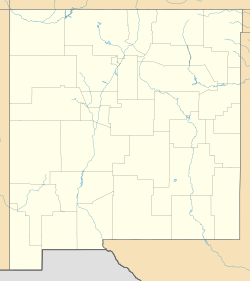Alvarado Hotel facts for kids
|
Alvarado Hotel
|
|
|
Formerly listed on the U.S. National Register of Historic Places
|
|

Alvarado Hotel, entrance to main courtyard
|
|
| Location | 110 1st St. SW, Albuquerque, New Mexico |
|---|---|
| Built | 1902 |
| Architect | Charles Frederick Whittlesey |
| Architectural style | Mission Revival |
| NRHP reference No. | 70000902 |
Quick facts for kids Significant dates |
|
| Added to NRHP | March 3, 1970 |
| Removed from NRHP | August 4, 1970 |
The Alvarado Hotel was a famous railroad hotel in Albuquerque, New Mexico. It was one of the most well-known buildings in the city. The Atchison, Topeka and Santa Fe Railway built it between 1901 and 1902. The Fred Harvey Company ran the hotel until 1970.
With 120 guest rooms, the Alvarado Hotel was the largest of all the Harvey hotels. When it was torn down in 1970, many people were very sad. This event helped people realize how important it was to save historic buildings in Albuquerque.
The hotel was designed by Charles Frederick Whittlesey. It was built in the Mission Revival style. This style often uses features like curved gables and arcades. The hotel was part of a bigger group of railroad buildings. These included the Santa Fe Depot (which burned down in 1993) and the Freight Office (which is still standing). Today, the Alvarado Transportation Center is located where the hotel once stood. This transportation center opened in 2002.
Contents
History of the Alvarado Hotel
The Alvarado was one of several Harvey House hotels. The Atchison, Topeka and Santa Fe Railway built these hotels along its train routes. They were built in the early 1900s. Other famous Harvey Houses included the Castañeda in Las Vegas, New Mexico, and El Tovar at the Grand Canyon.
Building and Opening
Charles Frederick Whittlesey designed the Alvarado Hotel. He also designed the El Tovar Hotel. The Alvarado Hotel officially opened on May 10, 1902. It was named after Hernando de Alvarado. He was a lieutenant who explored New Mexico with Francisco Vázquez de Coronado in 1540.
When it first opened, the hotel had 100 guest rooms. It also had 20 bathrooms, a large dining room, and a lunch counter. There was a barber shop, reading rooms, and special rooms for men and women. A unique part of the hotel was its "Indian Building." Here, tourists could buy interesting items from the Southwest.
Hotel Expansion and Popularity
In 1922, the hotel was updated and made bigger. It then had 120 rooms. More bathrooms were added to the existing rooms. The outdoor areas were also improved with new landscaping and fountains. Inside, the public spaces were redesigned by architect Mary Colter.
After these changes, the Alvarado became the largest of all the Harvey hotels. For many travelers, the hotel was their first look at the American Southwest. Writer Lawrence Clark Powell called it the region's "heart of hearts." The hotel was also a very important social spot for Albuquerque. It hosted many events, including the yearly Montezuma Ball.
End of an Era
By the 1960s, the Alvarado was one of the last Harvey hotels still open. It was starting to show its age and needed repairs. People heard rumors that it might be torn down. However, the city did not do much to save it. The hotel was listed on the New Mexico State Register of Cultural Properties in 1969. It was also added to the National Register of Historic Places in 1970.
In September 1969, the ATSF railway announced its plan. They would close the hotel on January 2, 1970, and then tear it down. The railroad offered to sell the property to the city. But the price was very high, much more than it was worth. In the end, the city government and people did not have enough interest or power to save the hotel. It was torn down as planned, starting on February 2, 1970.
Legacy of the Alvarado
Many people now see the demolition of the Alvarado Hotel as a big loss for Albuquerque. One architect said it "has truly haunted New Mexico." Even though the hotel could not be saved, its demolition had a positive effect. It made the community much more supportive of efforts to save other historic buildings in Albuquerque.
This event led to the creation of groups like the Albuquerque Conservation Association. It also led to the city's Historic Landmarks Survey. The land where the Alvarado once stood was used as a parking lot for many years. Then, in 2002, the Alvarado Transportation Center was built there. This new building was designed to look like the old hotel. It uses many of the same Mission Revival design elements.
Architecture of the Hotel
The Alvarado was a large, three-story building. It was designed in the Mission Revival style. The hotel was located at the corner of First Street and Central Avenue. It was at the north end of a four-block area of railroad buildings. This area also included the Santa Fe Depot and the Freight House (built in 1946). There was also a Curio Store (1912) and a Telegraph Office (1914), plus other buildings.
The hotel was built with a wood frame. It had tiled roofs and a rough, gray stucco outside. The stucco was put over a layer of steel lath. The main part of the hotel was shaped like an "E." It had three parts sticking out, each with a curved Mission-style gable. These parts faced the train tracks.
Between the hotel's wings were two courtyards. These courtyards were surrounded by arcades. These arcades also connected to the Indian Building, the depot, and other smaller buildings. The main entrance of the hotel had a pediment with a curved gable. This was flanked by two stepped towers.
See also
 In Spanish: Hotel Alvarado para niños
In Spanish: Hotel Alvarado para niños




